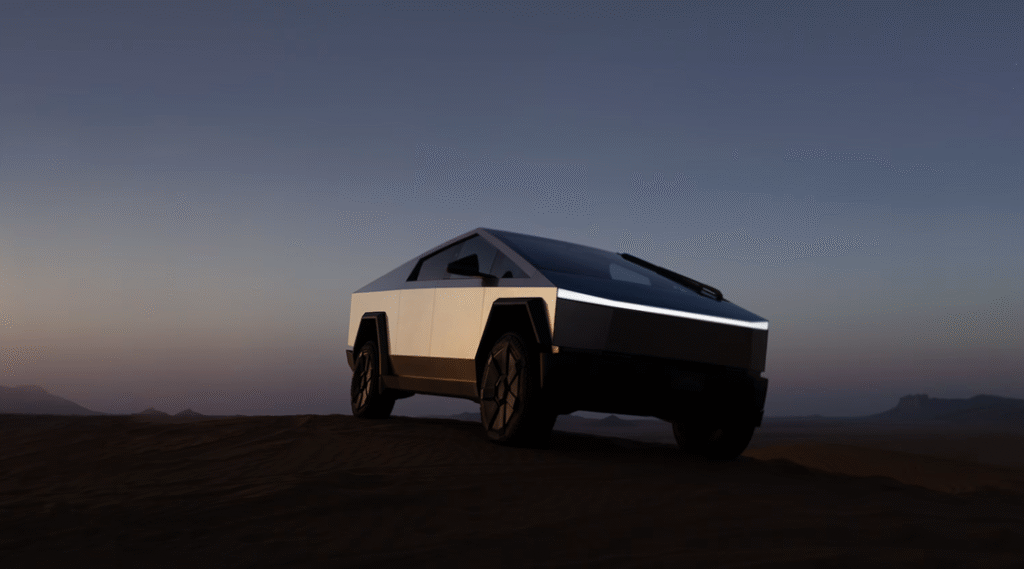Tesla’s Cybertruck arrives as a bold statement: a futuristic stainless-steel shell, impressive electric performance figures, and an explicit claim to rethink what a pickup can be. But radical styling and ambitious specs don’t automatically translate into a category-shifting product. Below I reframe what Cybertruck actually changes, where it nudges the industry forward, and the realistic hurdles it must clear to become the defining pickup of the future.
Tesla’s claims in practice
On specs alone, the Cybertruck presents itself as a capable electric utility vehicle: Tesla advertises competitive range numbers, brisk acceleration for higher trims, and substantial towing capacity depending on configuration. Its stainless-steel body and emphasis on toughness underline Tesla’s intention to offer a different structural and aesthetic approach compared with traditional pickups.
Where the Cybertruck advances the category
- New materials and structure — The use of a stainless-steel exoskeleton departs from the usual unibody or ladder-frame designs. This approach could change expectations about durability, impact resistance, and body construction, prompting competitors to revisit materials and manufacturing choices.
- Electric-first utility — With long range, strong drivetrain performance, and integration into Tesla’s charging ecosystem, the Cybertruck underscores how EV architecture can serve towing and heavy-use scenarios—areas where many expected EVs to be weaker.
- Shifting buyer expectations — The Cybertruck’s daring look and mix of performance and utility help reshape what buyers might expect from future pickups. Even conservative OEMs have accelerated electric truck programs and highlighted EV towing and utility in response to market pressure.
Practical constraints on the “reinvention” narrative
- Utility versus novelty: Many pickup buyers prioritize reliability, upfit options, serviceability, and predictable operating costs. Dramatic design alone won’t convince fleet buyers or traditional truck owners unless Tesla demonstrates real-world durability, uptime, and a competitive total cost of ownership in commercial settings.
- Scaling production and quality: Tesla has a history of ambitious production ramps. To lead the pickup market, Tesla must deliver high volumes with consistent build quality and a robust service footprint—areas that remain uncertain until mass deliveries and long-term usage data accumulate.
- Strong competitive responses: Established and newer OEMs are launching electric trucks that emphasize pragmatic features: familiar form factors, extensive dealer and service networks, and ecosystems built around conventional pickup use (accessories, bed integrations, etc.). Those strengths appeal to many mainstream buyers.

How competitors stack up-short comparison
- Ford F-150 Lightning: Focuses on conventional pickup function, leveraging Ford’s truck heritage, dealer/service reach, and features tailored to mainstream buyers—prioritizing practicality over radical design.
- Rivian R1T: Targets outdoor and adventure markets with clever storage and off-road capability; it aims for premium utility rather than the mass work-truck market.
- GMC Hummer EV: Delivers extreme off-road performance and spectacle in a familiar truck form, appealing to a premium niche that values capability and showmanship.
Influence versus dominance
The Cybertruck is already a catalyst: it pushes conversations about materials, styling, and what an electric pickup can be. For certain segments—early adopters, tech enthusiasts, and buyers drawn to Tesla’s ecosystem—it will feel revolutionary. Yet becoming the industry leader requires more than provocative design and headline specs. Tesla must translate its design and technical promise into reliable, large-scale adoption across mainstream consumers and fleets, backed by demonstrable TCO advantages and a service network that rivals legacy OEMs.
At this stage, Cybertruck looks more like a disruptive spark than a guaranteed category ruler. It will accelerate innovation across the pickup market and force incumbents to move faster. If Tesla succeeds at consistent production, broad service coverage, and clear ownership economics, the pickup landscape could indeed shift dramatically over the next decade. If it doesn’t, the Cybertruck will still be remembered as the disruptive idea that pushed a conservative industry to change faster than it otherwise would have.
More articles for the relative topic:
Model X Review: Is Tesla’s Flagship SUV a Smart Luxury Purchase?
Humanoid Robotics Face-Off: Assessing Tesla Optimus and Its Top Competitors
Why Tesla Embraced Pure Vision for Self‑Driving Supremacy
Is Tesla’s Self-Driving Technology Reliable? A Comprehensive Analysis
If Apple Had Stayed in the Car Business: How the Auto and Tech Landscapes Would Have Shifted
As for in-depth insight articles about AI tech, please visit our AI Tech Category here.
As for in-depth insight articles about Auto Tech, please visit our Auto Tech Category here.
As for in-depth insight articles about Smart IoT, please visit our Smart IoT Category here.
As for in-depth insight articles about Energy, please visit our Energy Category here.
If you want to save time for high-quality reading, please visit our Editors’ Pick here.



